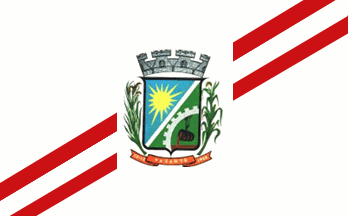 image by
Dirk Schönberger, 2 October 2010
image by
Dirk Schönberger, 2 October 2010Source: http://www.vazante.mg.gov.br/index.php?mn=2&smn=17

Last modified: 2011-02-05 by ian macdonald
Keywords: minas gerais | vazante |
Links: FOTW homepage |
search |
disclaimer and copyright |
write us |
mirrors
 image by
Dirk Schönberger, 2 October 2010
image by
Dirk Schönberger, 2 October 2010
Source:
http://www.vazante.mg.gov.br/index.php?mn=2&smn=17
A white field with two rising red diagonals, and the municipal arms centred on a white rectangle.
Official website at
http://www.vazante.mg.gov.br/
Dirk Schönberger, 2 October 2010
The municipality of Vazante (20,042 inhabitants in 2009; 1,909 sq. km) is
located in northwestern Minas Gerais, 450 km of Belo Horizonte. The first
settlement emerged near a chapel built after the apparition of a statue of the
Virgin of Lapa - one of the most revered saints in Portugal - in a cave.
Originally named Lapa, the settlement was made of the Vazante estate and the
sanctuary of the Virgin of Lapa, which were separated in 1920. Vazante was made
on 17 December 1938 a district by State Law No. 148, seceding from the district
of Guarda-Mor, part of the municipality of Paracatu. In 1933, zinc was
discovered by the Chilean engineer Ângelo Custódio Solis, a finding which was
subsequently confirmed by the geologist Alberto Vellasca, employed by the Cia.
Níquel Tocantins (Group Votorantim). Production started in 1969; today the mines
are exploited by the Cia. Mineira de Metais (6,000 t / month) and the Mineração Areiense (3,500 t / month). After a long dispute with Guarda-Mor, Vazante was
made on 12 December 1953 a municipality by State Law No. 1,039; the municipality
is made of the districts of Vazante (seat), Guarda-Mor and Claro de Minas.
Guarda-Mor was eventually made on 30 December 1962 an independent municipality
by State Law No. 2,764.
http://www.vazante.mg.gov.br/index.php?mn=2&smn=16 - Municipal website,
History section
The municipal flag obeys the norms prescribed by the
Law on the municipal symbols in Brazil. The flag, in
the official dimensions, is white with two red ascending diagonal stripes
charged in the middle with the municipal arms. White represents the
Virgin, therefore symbolizing peace, while the red stripes symbolize the
intensity of love for the town's patron saint, the Virgin of Lapa.
The
municipal coat of arms includes a Samnite shield, the first Portuguese shield
style, of French origin, recalling that the Latin race was the colonist and
the main builder of the Brazilian nationality [verbatim]. The mural crown
surmounting the shield has seven towers, of which four are visible; therefore
the arms belongs to a town of third rank, that is the seat of a municipality.
The shield is "Per bend sinister azure a sun or vert a crucible proper a
quarter of a gear wheel argent". Blue symbolizes justice, nobleness,
perseverance, zeal and loyalty, as applied by the locals in their efficient
work for the increase of the town. Green symbolizes the green fields and the
rich pastures fed by the fertile soil. The white bend represents the local
faith, expressed by the pilgrimage to the Virgin of Lapa, the town's patron
saint. The stylized yellow sun represents the tourism potential of the
municipality, via its charming caves and crystalline lakes. The crucible
surrounded by the gear wheel represents the mining resources of the
municipality, especially in zinc. The shield is surrounded dexter by a maize
plant and sinister by a rice plant, the main local crops. A red scroll
placed beneath the shield is charged with the name and foundation date
(12-12-1953) of the municipality, in white letters.
It is worth being
mentioned that the source shows a photo of the flag.
Ivan Sache, 6
October 2010